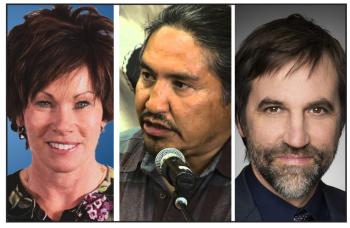Image Caption
Summary
Local Journalism Initiative Reporter
Windspeaker.com
Updated with information from Alberta Environment Minister Sonya Savage: May 15, 2023 at 11:30 (Alberta).
Environment Canada issued a statement March 13 saying the seepage from Imperial Oil's Kearl mine site, which is upstream of Athabasca Chipewyan First Nation (ACFN) and Mikisew Cree First Nation, is “believed to be deleterious, or harmful, to fish.”
Departmental officials visited the site on March 8 and collected additional samples.
To that end, says the statement, enforcement officers issued a Fisheries Act Direction to Imperial Oil.
“The Direction requires immediate action to contain the seep and prevent it from entering a fish-bearing waterbody,” reads the statement.
ACFN has been warning its members not to hunt, harvest or fish in the area of the Kearl site. Now they have federal government information to back up their concerns.
“We’ve been saying this all along, that the tailings pond leakage, somewhere down the line, something is going to be affected. The fish are going to be the first because it’s in the water,” said ACFN Chief Allan Adam.
However, in a statement released March 15, Alberta Environment Minister Sonya Savage said her department officials had completed independent water monitoring at Lake Athabasca and had “not seen any evidence of waterway, waterbody or drinking water contamination as a result of the incidents under investigation” at the Kearl site.
Monitoring undertaken by Alberta Environment is meant to complement and not replace the monitoring being carried out by the Alberta Energy Regulator and Imperial Oil.
Savage said she shared Alberta’s findings with her federal counterpart Minister Steven Guilbeault in a bilateral meeting March 14.
The Alberta Energy Regulator (AER) has been aware of the industrial wastewater seeping from the external tailings area both on and outside the boundaries of the Kearl site since May 19, 2022, when it issued an environmental protection order (EPO). The AER was notified by Kearl mine of seepages, including one in close proximity to Waterbody 3, which is fish-bearing, with tributaries that feed the Firebag and Muskeg rivers, which flow into the Athabasca River.
However, it wasn’t until AER issued an EPO this past Feb. 6 in response to at least 5.3 million litres of toxic chemicals that overflowed Feb. 4 from a dam at the Kearl mine into the environment and upstream of Fort Chipewyan, that ACFN was notified.
The wastewater exceeds federal and provincial guidelines for iron, arsenic, sulphates and hydrocarbons that could include kerosene, creosote and diesel.
Chief Adam told Windspeaker.com on March 10 that it was helpful that Minister Guilbeault was using the federal regulatory system in order to protect the waterways.
Environment Canada explains that a Fisheries Act direction is a compliance tool that may be issued by enforcement officers when there is an unauthorized deposit of a deleterious substance into water frequented by fish and immediate action is required.
“These are the concerns from the community’s point of view and if Environment Canada says there are harms to the fish, then it’s our job as community leaders to inform our people of the findings of what is happening,” said Adam.
Environment Canada’s statement does not include whether people should refrain from eating the fish or reduce their rate of consumption.
Environment Canada is working in coordination with AER to review Imperial’s remedial action plan in order to make sure it complies with the Fisheries Act.
“This enforcement file is in the inspection stage,” reads the statement from the federal department. Federal environment officers will continue to monitor the cleanup at the site, collect more inspection information to ensure compliance and “stay engaged with the AER and Imperial.”
Savage said she and Guilbeault have agreed to continue working together “and (are) committed to maintaining open communication channels with Indigenous communities in the area with updates on water sampling and other monitoring results.”
The establishment of federal-provincial working group is in discussion to ensure the accelerated collaboration on a long-term solution for the treatment and remediation of tailings ponds, said the Alberta Environment statement.
In a March 10 interview with Chief Adam, he called out Premier Danielle Smith for her statement saying there was no concern for the drinking water in the area of the seep. After hearing federal officials believed that the seep was harmful to fish, Adam warned, “Watch what you say. Make sure you get all the proper information. Don’t jump the gun. And don’t believe anybody if you’ve never seen first-hand information yourself.”
Never miss a Windspeaker article. Subscribe Today to our new Windspeaker Newsletter!
Local Journalism Initiative Reporters are supported by a financial contribution made by the Government of Canada.

